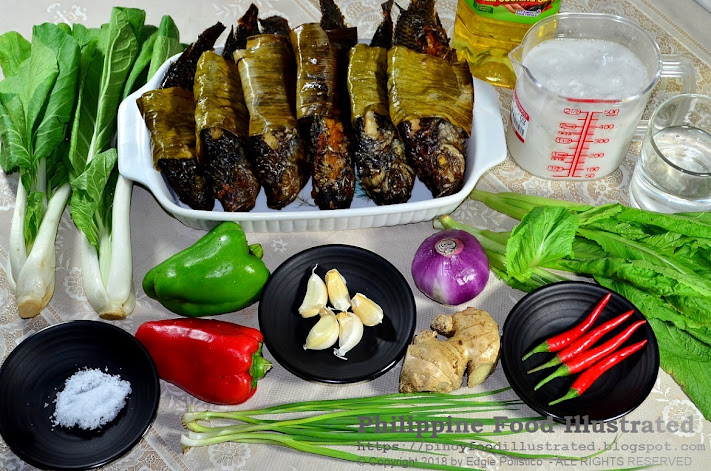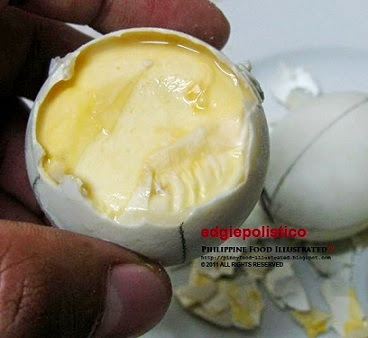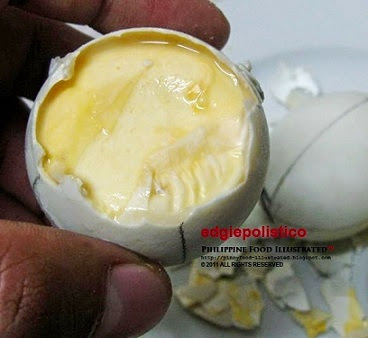mango chocolate - /mang-go tso-ko-leyt/ (Cebuano sweet; dw Eng. mango + chocolate) [n.] chocolate coated dried mango.
Other local name:
- a.k.a. choco mangga in Cebuano
The ripe or rareripe mango fruit is peeled and sliced into thin slabs. The slices are blanched or steamed in boiling sugar syrup added with a flavoring of choice.
The cooked sliced mango is strained and then dried either by sun drying or by heating in the oven. Big manufacturers used the “forced air dryer” method that utilizes a heater system to warm the air that is then blown using an industrial fan mechanism to dry the cooked sliced mangoes laid on wire mesh.
Philippine Brand mango chocolate by Profood International Corporation (Central Visayas Philippines).
When dried, the mango is set to cool and then dipped in melted chocolate and set to stand until the chocolate hardens to coat the dried mango. Dry dark chocolate is commonly used for melted chocolate. The chocolate is melted using the bain marie (or double boiler) technique. The chocolate may also be flavored with vanilla essence or vanillin.
Mango Chocolate by Cacao de Davao is dried mango chips coated with 75% dark cacao chocolate that is made with cacao beans that are grown, harvested, and sundried from Davao.
Mango chocolate is pioneered and popularized in Cebu as a sweet treat. Originating as the famous Cebu dried mango that became a popular pasalubong.
Philippine Brand mango chocolate by Profood International Corporation (Central Visayas Philippines)
The Cebu Best Mango Chocolate, which was launched in early 2011, claimed to be the first and original chocolate-dipped dried mango introduced in the market and was given as a gift to Pope Francis (Jorge Mario Bergogli) during his Papal Visit to the Philippines in 2015.
Mango Chocolate by Dutché Chocolates Philippines.
The Cebu Best Mango Chocolate also served as diplomatic giveaways, airline treats, and snacks for presidential flights.

Cebu Best Mango Chocolate are dried mangoes covered with delightful Belgian chocolate. It claimed to be the first and original chocolate-dipped dried mango introduced in the market.Photo courtesy by Cebu Best Mango Chocolate Fabecook page (@CebuBestMango)
There are now many makers of mango chocolate in the country that carry their own brand names.
The other name for mango chocolate is choco mangga.

Choco Mangga by R&M Preserves is made with chewy mango strips half-covered in velvety chocolate. It comes in dark and white chocolate variants that received the Golden Shell Award.
Related posts:

All photos by Edgie Polistico are copyrighted.
ALL RIGHTS RESERVED.
References:
- Cebu Best, Our Story, http://www.cebubestmango.com/#OurStory
- Olchondra, Riza T. “Pioneering R&M levels up from dried mangoes,” Philippine Daily Inquirer, July 26, 2013, https://business.inquirer.net/134567/pioneering-rm-levels-up-from-dried-mangoes
If you liked this post, share it.
Let us know your opinion on the subject. Feel free to comment in the comment section, below. It is important for us to know what you think.
Tell us what other topics you would like us to write, share, and discuss.
For more about Filipino food, try our Philippine Food, Cooking, and Dining Dictionary. It is OPEN and FREE.
Continue to follow my blogs. You can also follow and learn more by joining us in our Facebook group. Have more bits and pieces about our kind of food, ingredients, and ways of cooking, dining, and knowing food culture across the 7,641 islands of the Philippines. I will search for more and continue to share my findings. It is my pleasure to rediscover the known and least known things or the unheard ones and put them here for everyone to find, learn, and treasure.
Tell us what other topics you would like us to write, share, and discuss.
Sharing is happiness to me. If you are pleased and happy with what you found here, please share the happiness we have in the PHILIPPINE FOOD ILLUSTRATED. I feel energized when it becomes part of the reasons why you are happy and smiling.
Edgie Polistico























































